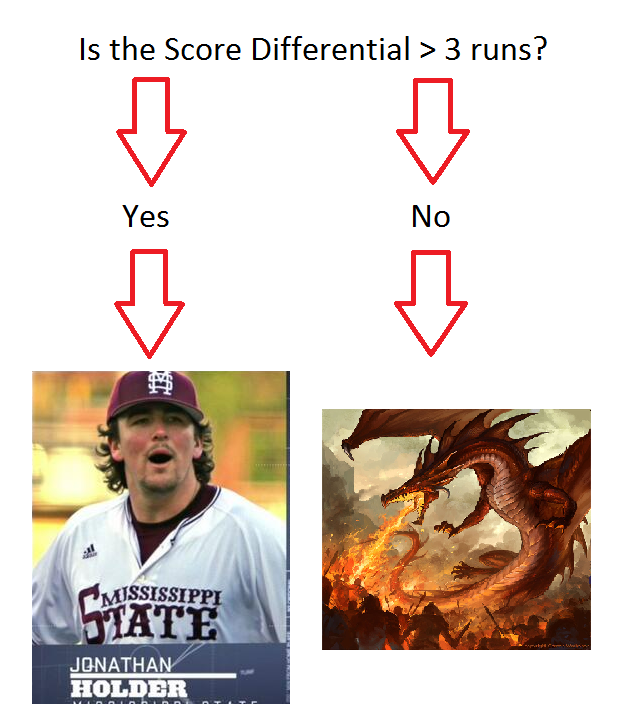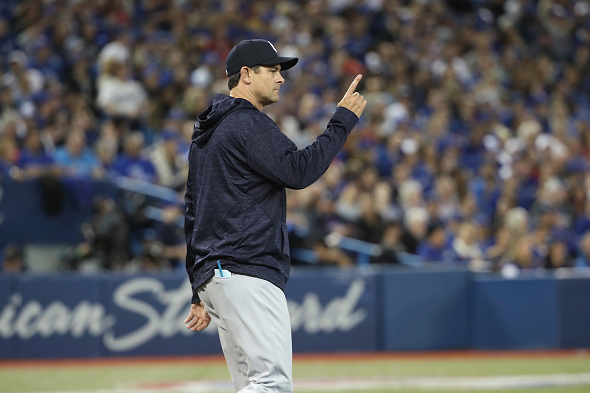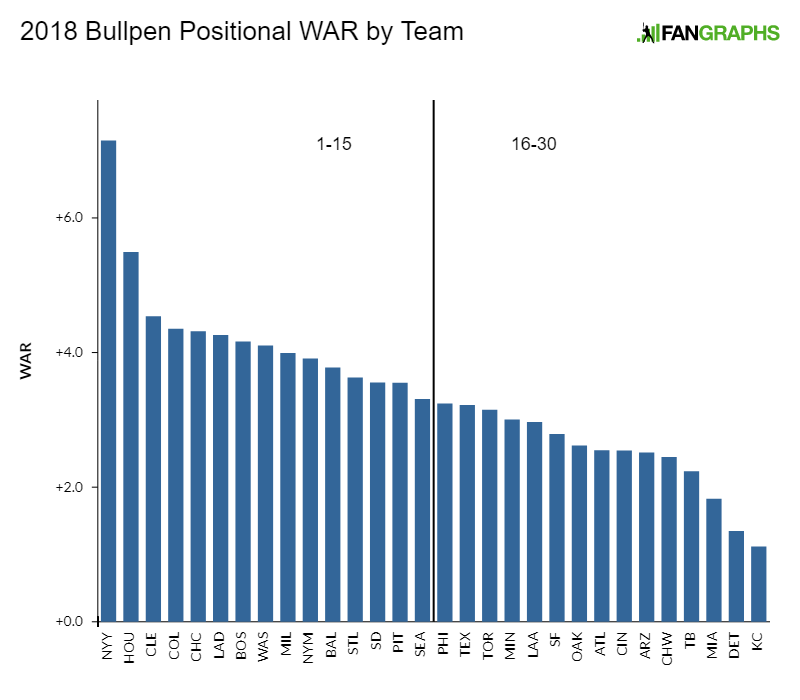Don’t look now, but the Yankees bullpen is awesome. Really, I swear. I know they’ve been absolutely dreadful so far this year – like a pile of garbage lit on fire and dumped in some nuclear waste – but they are far too talented to not turn it around. And in the past few games, they have started to pitch better. To show how unfathomably great this bullpen can (and I believe will) be, here is a chart from Fangraphs’ Travis Sawchik with projected WAR for all bullpens in baseball:
The Yankees projected bullpen WAR is 1.6 wins more than the second highest team, the Astros. That lead is the second largest among all positional groups, behind only Mike Trout’s ridiculous 4+ WAR lead over all other center fielders. In fact, the Yankees have a chance to break the all-time bullpen WAR record of 9.6 set by the 2003 Dodgers.
The reason for this possibility is twofold: 1. Last year’s bullpen recorded the second highest WAR total ever with 9.2 and that includes Tyler Clippard’s extreme suckitude (pretend it’s a word). 2. WAR is a counting stat, which means the more innings you pitch, the more WAR you likely accumulate. Since starting pitchers are throwing fewer and fewer innings, bullpens are used more which means they can accrue more WAR.
All of that is a long-winded way of saying the Yankees have assembled an incredible, potentially historic bullpen, and the important question is how to use it. Below I have split the Yankee relievers into tiers and explain their optimal usage.
Tier Closer: The Fire-Breathing Dragon
Aroldis Chapman remains one of the best closers in baseball. He throws so hard that on the MLB Statcast fastest pitches page, they have an option to remove all pitches thrown by Chapman so that other relievers have a chance to be noticed for their velocity. Whoever came up with that idea is my favorite MLB employee and I find it endlessly hilarious that option exists as a sign of respect to Chapman’s heat.
Unfortunately, Chapman has one major drawback in that he only likes to pitch in tie games or save situations. That usage is not always ideal, but when you have a fire-breathing dragon who only likes to eat goats, there is no sense in giving him fish for dinner.
Tier 1: The Disappearing Dragons
The reason it is okay that Chapman only wants to be used in specific situations is because he’s not actually the Yankees’ best reliever. That honor goes to Chad Green and David Robertson. I call them the disappearing dragons because Robertson is known as Houdini for his ability to escape jams and Green has a high spin-rate fastball that makes it appear faster than it is.
Analytics tells us that the most important inning is not necessarily the ninth, and that a more efficient way to use your best relievers is based on leverage. For example, if the middle of the order is up in the eighth inning, you want your best pitcher on the mound then rather than in the ninth when the bottom of the order is up.
To that end, Green and Robertson are often brought in with runners on base because that type of situation is very high leverage. An additional benefit is that both of these guys are capable of pitching multiple innings as we saw during last year’s playoff run.
Tier 2: The Large, Inaccurate Dragons
Behind Green and Robo-K (my preferred nickname for him) the Yankees have excellent options in Dellin Betances and Tommy Kahnle. When right, Dellin is one the five best relievers in baseball and Kahnle emerged last year as hard-throwing reliable back-end reliever. These guys are both incredibly big, throw hard, and are hard to hit. The issue is that their control can be anywhere from decent to downright awful on any given day. Here are the Yankee relievers’ walk-percentages over the past couple years:
- Dellin Betances: 16.7%
- Tommy Kahnle: 10.1%
- Aroldis Chapman: 9.7%
- David Robertson: 8.5%
- Chad Green: 6.4%
You can see that Betances and Kahnle walk significantly more batters than the other relievers in the bullpen. Those control issues lead to more runners on base and more stressful situations. The walk issues also make it a bad idea to bring one of these guys in when there are already runners on base because they may walk more people and exacerbate the situation. For this reason, they are a tier below Green and Robertson.
Tier 3: The Not-Dragons But Still Very Good
Adam Warren and Chasen Shreve are both amazing middle relief options. On most teams, these guys would be asked to pitch in the latter innings in high leverage situations, but on the Yankees, that’s not necessary. Warren is awesome because he can go multiple innings and Shreve is a fantastic seventh option out of the bullpen. It’s easy to overlook these guys, but you shouldn’t. On Saturday at the BP game event, the Orioles went to a pitcher named Jimmy Yacabonis and my reaction was “um who?” which tells you all you probably need to know about Jimmy Yacabonis’ track record. The Yankees don’t have that issue because of guys like Warren and Shreve.
Tier 4: The Other Guys aka Scranton Shuttle
The Yankees like to have eight relievers for whatever reason, so you end up with a guy like Jonathan Holder. Now with Joe Girardi, often the last guy in the bullpen would go weeks between outings and people joked that the reliever must have kicked Girardi’s dog or done something else to piss him off.
With Boone, it appears to be the opposite. I don’t know if Holder rescued Boone’s dog or something, but Boone Kept. Bringing. Holder. In. During. Close. Games. I know his last name is Holder, but there is NO NEED to bring him into situations where he can get a hold. In fact, that is the exact opposite time to bring in the last guy in the pen. You have a bullpen full of dragons yet you bring in their proverbial goat dinner to pitch in important spots? Here is a flowchart to help Boone out:

When the game is close, bring in one of your best relievers. When it’s not, bring in the low leverage guys. It sounds straightforward, but apparently not.
How is Boone Doing?
The short answer: not bad.
You ever have a supervisor or someone who no matter what you did would find a small flaw with it and only focus on that flaw? Like you do an amazing job on a project and the only comment is a small critique? That’s (probably) everyone with bullpen evaluations. When the relievers strike everyone out, it’s a good day. But the second they give up a run, everyone starts second guessing the manager.
Bullpen decisions happen in the most high leverage situations, so they are salient and can visibly alter the game. The anger and emotions are justifiable, and it’s easy to overlook the 20 decisions that worked well and only focus on the one that didn’t, like the nitpicky supervisor. Here are thoughts on Boone’s bullpen management so far, some good and some bad
He has not assigned innings
And thank goodness for that. Girardi liked to have a seventh inning guy and an eighth inning guy, and on occasion even a sixth inning guy. That system is nice and neat but it does not account for leverage. Like I said above, the high leverage situation in a game can be in any of the later innings.
Sure, Boone still uses Chapman to close, but he lets leverage and matchups determine his other bullpen decisions which is refreshing to see. For example, against the Blue Jays, he had Kahnle face a few lefties then brought in Robertson to face the righties. Kahnle’s best off-speed pitch is his changeup which is most effective against lefties. Robertson’s curveball is effective against both righties and lefties, so it made sense to use Kahnle first against those lefties.
He lets guys go more than one inning
And thank goodness for that. Green is a multi-inning shutdown weapon, and all of the other Tier 1 and 2 guys can be as well. You don’t want to leave guys in too long because they lose effectiveness, but there is a clear benefit to letting a guy go more than one inning if he’s having a good day. Here’s why:
I work in two different places, but take a one mile local bus from the subway to each place. One of the routes has six quick traffic lights on it. The other has one long one. If all the lights are green, the first trip is quicker. But if more than one light is red, then I’d rather the second trip. Most days, the second trip is significantly quicker. It’s the same with relievers. The fewer relievers you use, the fewer chances there are that you run into a red light metaphorically speaking.
My ideal bullpen usage in a close game would be to use Betances or Kahnle for an inning after the starting pitcher leaves. Then bring him out for a second inning. If he’s pitching well, great, you get two innings. If he gets in trouble, bring in Green or Robertson to clean it up and then finish getting you to Chapman. That type of plan is not always possible, but the idea is to use fewer relievers per game so that you always have high leverage guys ready the next day. The Yankees have five amazing relievers. If you use 2-3 per game, you will always have 2-3 available the next day because they just had a day off.
Jonathan &@@^!% Holder
I know, I already talked about this. But seriously, what was up with the first two times that Boone brought Holder in? The first was in the middle of the sixth inning against Toronto and he let an inherited runner score. According to Baseball-Reference, this was a high leverage situation. The second was in the sixth inning of the home opener where he squandered a three run lead. Again, this was a very high leverage situation. Thankfully by his third outing, Boone saved him until absolutely necessary in extra innings. That’s what the last guy in your bullpen is there for.
All in all, the Yankees have an incredible bullpen which will (I guarantee with 99% certainty) turn it around and be a huge strength for this team. Boone is a young manager who is still learning the ropes and hopefully he continues to get better.
The bullpen is the Yankees greatest advantage over the rest of the league and if used properly will propel them towards October.
Follow me on twitter at @rohanarcot20





